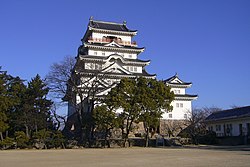Fukuyama Castle
| Fukuyama Castle 福山城 | |
|---|---|
| Fukuyama, Japan | |
 | |
| Type | Azuchi-Momoyama castle |
| Height | (five stories) |
| Site information | |
| Controlled by | Mizuno clan (1622-1700), Matsudaira Tadamasa (1700-1710), Abe clan (1710-1874), Japan (1874-present) |
| Condition | Reconstructed, serves as history museum |
| Site history | |
| Built | 1619-1622, rebuilt 1966 |
| Built by | |
| In use | 1622-1874 |
| Materials | stone, wood, plaster walls (original); concrete, steel, wood, stone, plaster (reconstruction) |
| Demolished | 8 August 1945 |
Fukuyama Castle (福山城, Fukuyama-jō), sometimes called Hisamatsu Castle (久松城, Hisamatsu-jō) or Iyō Castle (葦陽城, Iyō-jō) was the castle of the Bingo-Fukuyama Han during the Edo period[1] of Japanese history. The castle is located in in Fukuyama, Hiroshima near Fukuyama Station.
Overview[]
The castle was built on a hill on the Fukuyama plain and it was the capital of Bingo Fukuyama Han. Construction was started in 1619 during the Genna era, and was completed in 1622.[2] The castle was created by Mizuno Katsunari, one of the first Tokugawa hereditary vassals,[3] on order by the Tokugawa shōgun. The castle stood seven stories tall, and was surrounded by double moats which provided an inlet to the Seto Inland Sea.[1] The Mizuno clan maintained control over the castle from its construction until 1700.
Fukuyama Castle was one of the tenshu that survived the Meiji Restoration, however it suffered extensive damage from Allied attacks in World War II; most buildings of the castle were destroyed.[4] Most of the dry stone was later removed, and Fukuyama Station was built very near where the castle stood. The main tower was rebuilt with concrete in 1966.[1]
See also[]
References[]
- ^ Jump up to: a b c Mitchelhill, Jennifer; Green, David (2018). Samurai Castles: History, Architecture, Visitors' Guide. Rutland, Vermont: Tuttle Publishing. pp. 114–117. ISBN 4805313870.
- ^ "Fukuyama Castle". Japan Travel. 2018. Retrieved 6 September 2018.
- ^ "Fukuyama Castle". JCastle. Retrieved 6 September 2018.
- ^ Mitchelhill, Jennifer; Green, David (2018). Samurai Castles: History, Architecture, Visitors' Guide. Rutland, Vermont: Tuttle Publishing. p. 18. ISBN 4805313870.
Literature[]
- Benesch, Oleg and Ran Zwigenberg (2019). Japan's Castles: Citadels of Modernity in War and Peace. Cambridge: Cambridge University Press. p. 374. ISBN 9781108481946.
- Schmorleitz, Morton S. (1974). Castles in Japan. Tokyo: Charles E. Tuttle Co. ISBN 0-8048-1102-4.
External links[]
 Media related to Fukuyama Castle at Wikimedia Commons
Media related to Fukuyama Castle at Wikimedia Commons
- Castles in Hiroshima Prefecture
- Fukuyama, Hiroshima
- Houses completed in 1622
- 1622 establishments in Japan
- Buildings and structures in Japan destroyed during World War II

